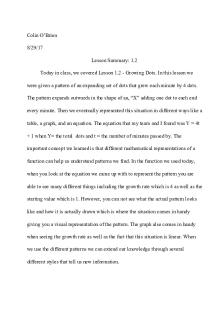Lesson Summary - 3.1 PDF

| Title | Lesson Summary - 3.1 |
|---|---|
| Author | Colin O'Brien |
| Course | Mathematics |
| Institution | University of California, Berkeley |
| Pages | 2 |
| File Size | 54.8 KB |
| File Type | |
| Total Downloads | 82 |
| Total Views | 126 |
Summary
lesson summary...
Description
Colin O’Brien 10/7/17 Lesson Summary: 3.1 - Getting Ready for a Pool Party Concepts We Covered: - Creating a graph based on a given situation. For example, using the situation from Lesson 3.1 about Sylvia and her pool party, I can make a graph for the process of draining, cleaning, and refilling her pool. When I made my graph, I started by thinking Sylvia would try to empty the pool by herself with a bucket, but then that took too long so she had two of her friends come over and they each used their own buckets to help empty the pool. They realized how slow this process was and tried using the hose instead because it was faster. After draining the pool completely with the hose, they cleaned the pool and got tired so they took a break. After that Sylvia started filling the pool until it was full and ready for the party. You can see in my graph how each different phase is represented and labeled. - Using a story context to graph and describe key features of functions. For example, using the same situation from Lesson 3.1, I made my own story as shown above and used that to make my graph. Notice how using buckets does not have a constant rate as you can’t constantly empty a pool using a bucket because there is time when you’re dumping out the full bucket, and also putting that now empty bucket in the water again. Notice how since it was given in the problem, draining and filling the pool are happening at the same rate just filling is increasing and draining is decreasing. Also, when cleaning and taking a break, the water level does not change as the pool is not being filled or drained. Also, after the pool is ready and filled back to the top, the line flattens as the pool can’t get more full. - Making assumptions and how they affect your graph of a function. For example, in the situation in Lesson 3.1, I made many assumptions that shaped my graph. First, I assumed that the events would take place in the order of 1 bucket, 3 buckets, draining with hose, cleaning, break, filling with hose. Had I instead chosen to maybe start with draining with the hose and
ending with the different buckets then my graph would’ve shown a fast decrease in the beginning and then near the point when the pool is almost empty the rate is no longer constant nor very fast which would be the section in which the buckets are used. I assumed how long each activity was done for, that the filling and draining of the pool was a constant rate, and I assumed that the hose draining the pool would be faster than the buckets. Not to mention that 3 buckets would be 3 times as fast. Also, that when using 3 buckets they would all lift and dump at the exact same time, there were many different ways that the buckets could’ve been represented. Vocabulary We Learned: - Function: When if for every input there is exactly one output. For example, if you compare the two tables below, based on our knowledge, the table on the left is function because for every input there can be only one possible output while the one on the right is not a function....
Similar Free PDFs

Lesson 2 Reading Summary
- 2 Pages

Lesson Summary - 3.1
- 2 Pages

Lesson Summary - 1.5
- 3 Pages

Lesson Summary - 6.1
- 2 Pages

TEMA 31 - Apuntes 31
- 4 Pages

Articles Summary - Lesson 4
- 4 Pages

Lesson Summary - 2.2
- 3 Pages

Lesson Summary - 4.1
- 2 Pages

Lesson Summary - 7.5
- 3 Pages

Lesson Summary - 1,2
- 3 Pages

Reading Summary Lesson 1
- 1 Pages

Test-bank-31 - Test-bank-31
- 14 Pages

Excercise 31
- 2 Pages
Popular Institutions
- Tinajero National High School - Annex
- Politeknik Caltex Riau
- Yokohama City University
- SGT University
- University of Al-Qadisiyah
- Divine Word College of Vigan
- Techniek College Rotterdam
- Universidade de Santiago
- Universiti Teknologi MARA Cawangan Johor Kampus Pasir Gudang
- Poltekkes Kemenkes Yogyakarta
- Baguio City National High School
- Colegio san marcos
- preparatoria uno
- Centro de Bachillerato Tecnológico Industrial y de Servicios No. 107
- Dalian Maritime University
- Quang Trung Secondary School
- Colegio Tecnológico en Informática
- Corporación Regional de Educación Superior
- Grupo CEDVA
- Dar Al Uloom University
- Centro de Estudios Preuniversitarios de la Universidad Nacional de Ingeniería
- 上智大学
- Aakash International School, Nuna Majara
- San Felipe Neri Catholic School
- Kang Chiao International School - New Taipei City
- Misamis Occidental National High School
- Institución Educativa Escuela Normal Juan Ladrilleros
- Kolehiyo ng Pantukan
- Batanes State College
- Instituto Continental
- Sekolah Menengah Kejuruan Kesehatan Kaltara (Tarakan)
- Colegio de La Inmaculada Concepcion - Cebu


